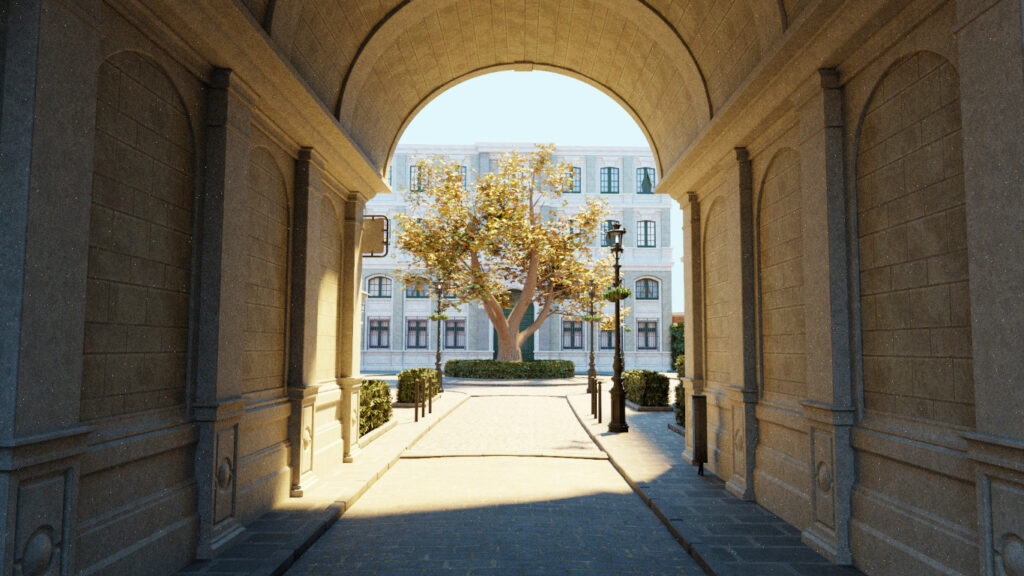See more screenshots in the screenshots directory.
This is a GPU “software” raytracer (i.e. using manual ray-scene intersections and not RTX) written using the WebGPU API. It expects a single glTF scene as input. It supports flat-colored and textured materials with albedo, normal, and material maps. It doesn’t support refraction (yet).
There are a bunch of test scenes in the test_scenes directory.
It uses wgpu-native WebGPU implementation, and SDL2 to create a window to render to.
To run the program, first build it (see instructions below), then run it with a single glTF scene in the command arguments. For example, if you’ve built the project in a build directory inside the project root, then you can run ./webgpu-raytracer ../test_scenes/bunny/bunny_100k.gltf.
An optional second command-line parameter defines the background of the scene. It can either be an RGB comma-separated triple like 1,0.5,0.25, or path to an HDRI environment map. The env_maps directory contains some sample enrivonment maps.
By default, a simple preview of the scene is rendered. Press [SPACE] to activate raytracing.
Here are all the controls:
- Mouse (while pressing left mouse button): rotate the camera
[Q][E]: roll the camera[W][A][S][D]: move the camera[LSHIFT][LCTRL]: speed up / slow down camera controls[SPACE]: activate raytracing
If the camera changes in raytracing mode, the raytracing result is discarded and the preview mode is activated again (i.e. there’s no temporal reprojection in this case).
- The raytracer uses standard Monte-Carlo integration with multiple importance sampling, see the corresponding shader.
- Fast ray-scene intersections are done using a BVH built with a simple surface-area heuristic at program start (see Jacco Bikker’s amazing article series about this).
- Raytracing uses multiple importance sampling (MIS) between several direction sampling strategies: cosine-weighted (good for diffuse materials), direct light sampling (good for rough materials), VNDF sampling (good for smooth materials), and transmission sampling (good for transparent materials). See also my article explaining how MIS works.
- The material used is the standard glTF Cook-Torrance GGX with a thin-walled transmission as described by KHR_materials_transmission.
- VNDF normals distribution is used to improve convergence.
- Refractive materials are not supported. I tried to incorporate refractions into VNDF sampling but never managed to figure it out; this work resides in a separate
vndf-refraction-wipbranch. - NB: the
use camera.wgsl;construct in the shaders is not standard WGSL, – instead, a rudimentary shader importing mechanism is implemented in this project.
With no promises of implementing any of this, in no particular order:
- ✅ Support environment maps & a fixed-color environment
- ✅ Sample emissive triangles in proportion to area & intensity (probably using Vose alias method)
- ✅ Support albedo, material & normal maps
- Sample environment map pixels in proportion to intensity (using the same alias method)
- Implement refraction + VNDF
- Incorporate tinybvh and test different BVH variants for performance
- Implement wavefront path-tracing
- Support GLB input scenes
To build this project, you need
To install wgpu-native, download some release archive for your platform, and unpack it somewhere. This project was built with the v0.19.4.1 release, and might not work with older versions.
Don’t forget to check out submodules:
- glm for vector & matrix maths
- rapidjson for parsing glTF scenes
- stb for loading images
You can do this at clone time, using git clone . Add --shallow-submodules to prevent loading the whole commit history of those submodules. Otherwise, you can checkout submodules at any time after cloning the repo with git submodule update --init --recursive.
Then, follow the usual steps for building something with CMake:
- Create a build directory
- In the build directory, run
cmake-DWGPU_NATIVE_ROOT= - Build the project:
cmake --build .
The include/webgpu-demo/sdl2_wgpu.h and source/sdl2_wgpu.c files implement a function WGPUSurface SDL_WGPU_CreateSurface(WGPUInstance, SDL_Window *) which creates a WebGPU surface from an SDL2 window, and should work on Linux (X11 and Wayland), Windows and MacOS. It is mostly based on glfw3webgpu.
These files are almost standalone, and can be copied directly into your project, if you want to use WebGPU with SDL2. Note that the sdl2_wgpu.c file needs to be compiled as Objective-C for MacOS (add -x objective-c to compile flags for this file), and the QuartzCore framework needs to be linked with your application (add -framework QuartzCore to your linker flags).
The cmake/Findwgpu-native.cmake find script is also useful on its own, and can be used in other CMake-based projects. Simply add its location to CMAKE_MODULE_PATH, and call find_package(wgpu-native). It creates a wgpu-native imported library that can be simply linked to your executable via target_link_libraries (it sets up include directories automatically).


